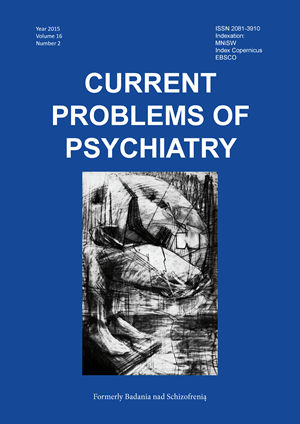Jak sprawcy przemocy domowej postrzegają siebie?
Słowa kluczowe:
domestic violence, aggression perpetrators of domestic violence, self - imageAbstrakt
The aim of our study was to investigate the relationship between self-image and the intensity of various kinds of aggressiveness in the imprisoned perpetrators of domestic violence pursuant to Art. 207 of the Penal Code (physical and mental abuse) based on data obtained from these perpetrators regarding functioning of their generational family.
The study involved 37 men – perpetrators of domestic violence, currently serving a sentence of imprisonment. They were convicted due to the recognition of their guilt for physical abuse and psychological torment of their families. The average age of subjects was 42.3 years. The control group consisted of 32 men, never convicted. The average age was 37 years. The following research methods were used: Adjective Test ACL, the scale “Moods and humors" and the Community Interview of own design.
Statistically significant difference is visible in indirect aggression – it is higher in the group of perpetrators who experienced domestic violence in their generational families; however in general there is a higher severity and also various kinds of global aggression in the group of offenders who experienced violence in their generational families. Stepwise linear regression results indicate that the use of violence are explained by the following characteristics of the self-image: rejecting attitude towards other people, lack of persistence and impulsiveness, tendency to break the social norms, lack of accountability, autonomy, planning and predicting the effects of own actions.
The results show an important role of generational family environment and parents’ attitudes in particular for future satisfactory social functioning.
Bibliografia
• Diagnoza dotycząca osób stosujących przemoc w rodzinie: komentarz do wyników badań. Raport z badania eksperckiego Ideablog zrealizowanego na zamówienie Min. Pracy i Polityki Społ., 2011 r.
• European Union Agency for Fundamental Rights, „Violence against women: an EU-wide survey. Main results” Luxembourg 2014.
• Juros A, Oleś P. Struktura czynnikowa i skupieniowa Testu Przymiotnikowego ACL H.G. Gougha i A.B. Heilbruna. W: Brzeziński J, Hornowska E. red. Z psychometrycznych problemów diagnostyki psychologicznej. Poznań: Wydawnictwo Naukowe Uniwersytetu im. A. Mickiewicza; 1993. s. 171–201.
• Stanisz A. Przystępny kurs statystyki z zastosowaniem STATISTICA PL na przykładach z medycyny. Kraków: StatSoft; 2006.
• Francuz P., Mackiewicz R. Przewodnik po metodologii i statystyce, nie tylko dla psychologów. Lublin: Wydawnictwo KUL; 2005.
• Stodulska-Blaszke A., Wójcicka A. Sprawcy przemocy domowej, – dlaczego stosują przemoc? Próba wyjaśnienia zjawiska. Badania pilotażowe. Current Problems of Psychiatry 2010; 11(4): 346-349
• Browne K.D. Violence in the family and its links to child abuse. Baillieres Clinical Peadiatrics, 1993; 1(1): 149-164.


